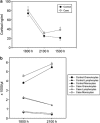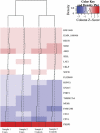Dexamethasone stimulated gene expression in peripheral blood is a sensitive marker for glucocorticoid receptor resistance in depressed patients
- PMID: 22237309
- PMCID: PMC3327850
- DOI: 10.1038/npp.2011.331
Dexamethasone stimulated gene expression in peripheral blood is a sensitive marker for glucocorticoid receptor resistance in depressed patients
Erratum in
- Neuropsychopharmacology. 2012 Jul;37(8):1972
Abstract
Although gene expression profiles in peripheral blood in major depression are not likely to identify genes directly involved in the pathomechanism of affective disorders, they may serve as biomarkers for this disorder. As previous studies using baseline gene expression profiles have provided mixed results, our approach was to use an in vivo dexamethasone challenge test and to compare glucocorticoid receptor (GR)-mediated changes in gene expression between depressed patients and healthy controls. Whole genome gene expression data (baseline and following GR-stimulation with 1.5 mg dexamethasone p.o.) from two independent cohorts were analyzed to identify gene expression pattern that would predict case and control status using a training (N=18 cases/18 controls) and a test cohort (N=11/13). Dexamethasone led to reproducible regulation of 2670 genes in controls and 1151 transcripts in cases. Several genes, including FKBP5 and DUSP1, previously associated with the pathophysiology of major depression, were found to be reliable markers of GR-activation. Using random forest analyses for classification, GR-stimulated gene expression outperformed baseline gene expression as a classifier for case and control status with a correct classification of 79.1 vs 41.6% in the test cohort. GR-stimulated gene expression performed best in dexamethasone non-suppressor patients (88.7% correctly classified with 100% sensitivity), but also correctly classified 77.3% of the suppressor patients (76.7% sensitivity), when using a refined set of 19 genes. Our study suggests that in vivo stimulated gene expression in peripheral blood cells could be a promising molecular marker of altered GR-functioning, an important component of the underlying pathology, in patients suffering from depressive episodes.
Figures



Similar articles
-
Genetic variation in FKBP5 associated with the extent of stress hormone dysregulation in major depression.Genes Brain Behav. 2013 Apr;12(3):289-96. doi: 10.1111/gbb.12026. Epub 2013 Mar 7. Genes Brain Behav. 2013. PMID: 23406438
-
Hypothalamic-pituitary-adrenal axis dysfunction and illness progression in bipolar disorder.Int J Neuropsychopharmacol. 2014 Oct 31;18(1):pyu043. doi: 10.1093/ijnp/pyu043. Int J Neuropsychopharmacol. 2014. PMID: 25522387 Free PMC article.
-
Corticosteroid receptor expression and in vivo glucocorticoid sensitivity in multiple sclerosis.J Neuroimmunol. 2014 Nov 15;276(1-2):159-65. doi: 10.1016/j.jneuroim.2014.07.004. Epub 2014 Jul 15. J Neuroimmunol. 2014. PMID: 25175068
-
How to measure glucocorticoid receptor's sensitivity in patients with stress-related psychiatric disorders.Psychoneuroendocrinology. 2018 May;91:235-260. doi: 10.1016/j.psyneuen.2018.01.023. Epub 2018 Feb 2. Psychoneuroendocrinology. 2018. PMID: 29449045 Review.
-
Glucocorticoid receptors in major depression: relevance to pathophysiology and treatment.Biol Psychiatry. 2001 Mar 1;49(5):391-404. doi: 10.1016/s0006-3223(00)01088-x. Biol Psychiatry. 2001. PMID: 11274650 Review.
Cited by
-
The moderating effect of cortisol and dehydroepiandrosterone on the relation between sleep and depression or burnout.Compr Psychoneuroendocrinol. 2021 Mar 27;7:100051. doi: 10.1016/j.cpnec.2021.100051. eCollection 2021 Aug. Compr Psychoneuroendocrinol. 2021. PMID: 35757064 Free PMC article.
-
Dual-Specificity Phosphatase Regulation in Neurons and Glial Cells.Int J Mol Sci. 2019 Apr 23;20(8):1999. doi: 10.3390/ijms20081999. Int J Mol Sci. 2019. PMID: 31018603 Free PMC article. Review.
-
Dexamethasone-Induced FKBP51 Expression in CD4+ T-Lymphocytes Is Uniquely Associated With Worse Asthma Control in Obese Children With Asthma.Front Immunol. 2021 Oct 15;12:744782. doi: 10.3389/fimmu.2021.744782. eCollection 2021. Front Immunol. 2021. PMID: 34721414 Free PMC article. Clinical Trial.
-
Genome-wide DNA methylation investigation of glucocorticoid exposure within buccal samples.Psychiatry Clin Neurosci. 2019 Jun;73(6):323-330. doi: 10.1111/pcn.12835. Epub 2019 Mar 28. Psychiatry Clin Neurosci. 2019. PMID: 30821055 Free PMC article.
-
The role of Akt/FoxO3a in the protective effect of venlafaxine against corticosterone-induced cell death in PC12 cells.Psychopharmacology (Berl). 2013 Jul;228(1):129-41. doi: 10.1007/s00213-013-3017-9. Epub 2013 Mar 15. Psychopharmacology (Berl). 2013. PMID: 23494228
References
-
- Binder EB. The role of FKBP5, a co-chaperone of the glucocorticoid receptor in the pathogenesis and therapy of affective and anxiety disorders. Psychoneuroendocrinology. 2009;34 (Suppl 1:S186–S195. - PubMed
-
- Breiman L. Random Forests. Machine Learning. 2001;45:5–32.
Publication types
MeSH terms
Substances
LinkOut - more resources
Full Text Sources
Other Literature Sources
Medical
Research Materials
Miscellaneous

